Abstract
Spleen cell cultures from guinea pigs given legionella pneumophila vaccine in complete Freund adjuvant or as a sublethal infection were inhibited in their migration activity in vitro when incubated with specific antigen. Both direct and indirect migration inhibition assays revealed sensitization of the guinea pigs to the bacterium, with demonstrable reactivity 25 to 40 days or more after sensitization. No consistent reactions occurred when the guinea pigs were given the killed Legionella vaccine in incomplete Freund adjuvant in saline. However, spleen cells from guinea pigs injected with sublethal doses of the Legionella vaccine 3 to 4 weeks earlier showed positive migration inhibition factor reactivity. Cutaneous hypersensitivity and lymphocyte blastogenic responsiveness in vitro also developed in guinea pigs sensitized with killed Legionella vaccine in complete adjuvant or given a sublethal infection with the bacterium. These results indicate that in vitro assays for migration inhibitory activity may be utilized to monitor the development of the sensitization of guinea pigs to L. pneumophila, and such reactions correlate with skin reactivity and in vitro lymphocyte blastogenic responses.
Full text
PDF
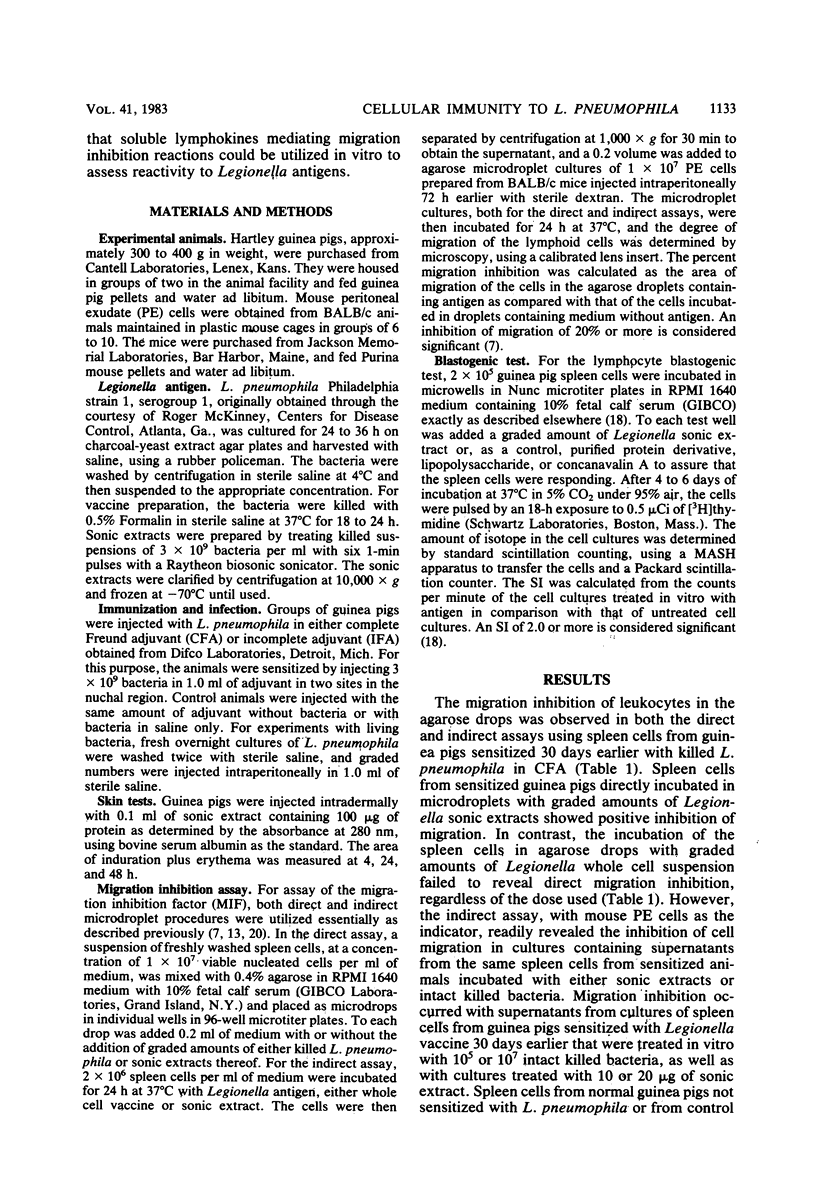
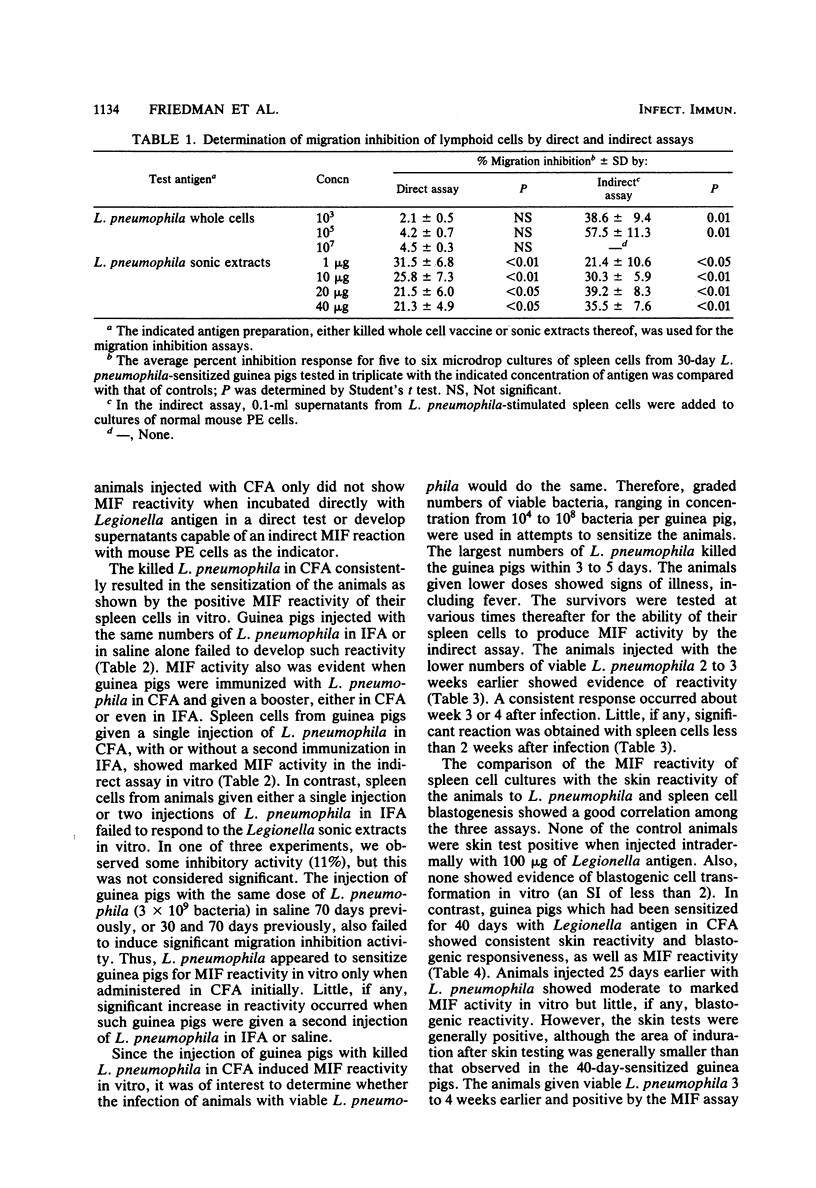
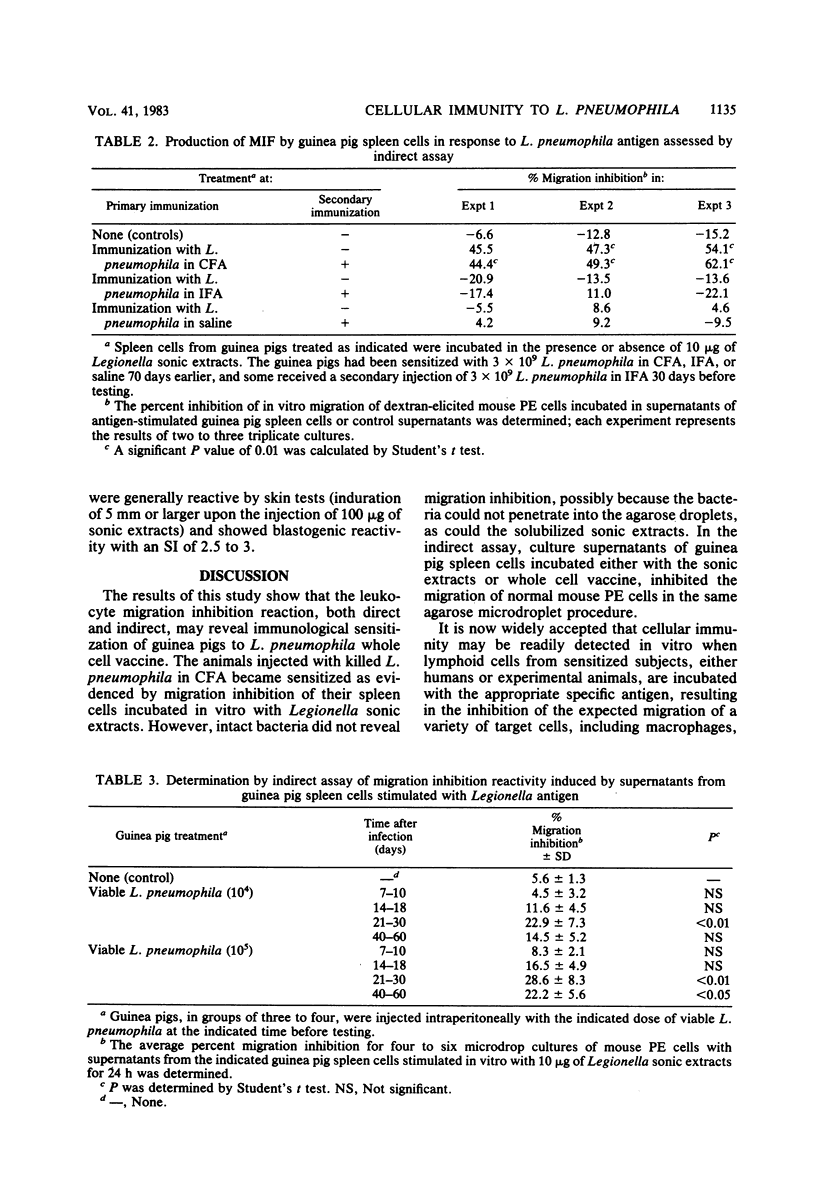
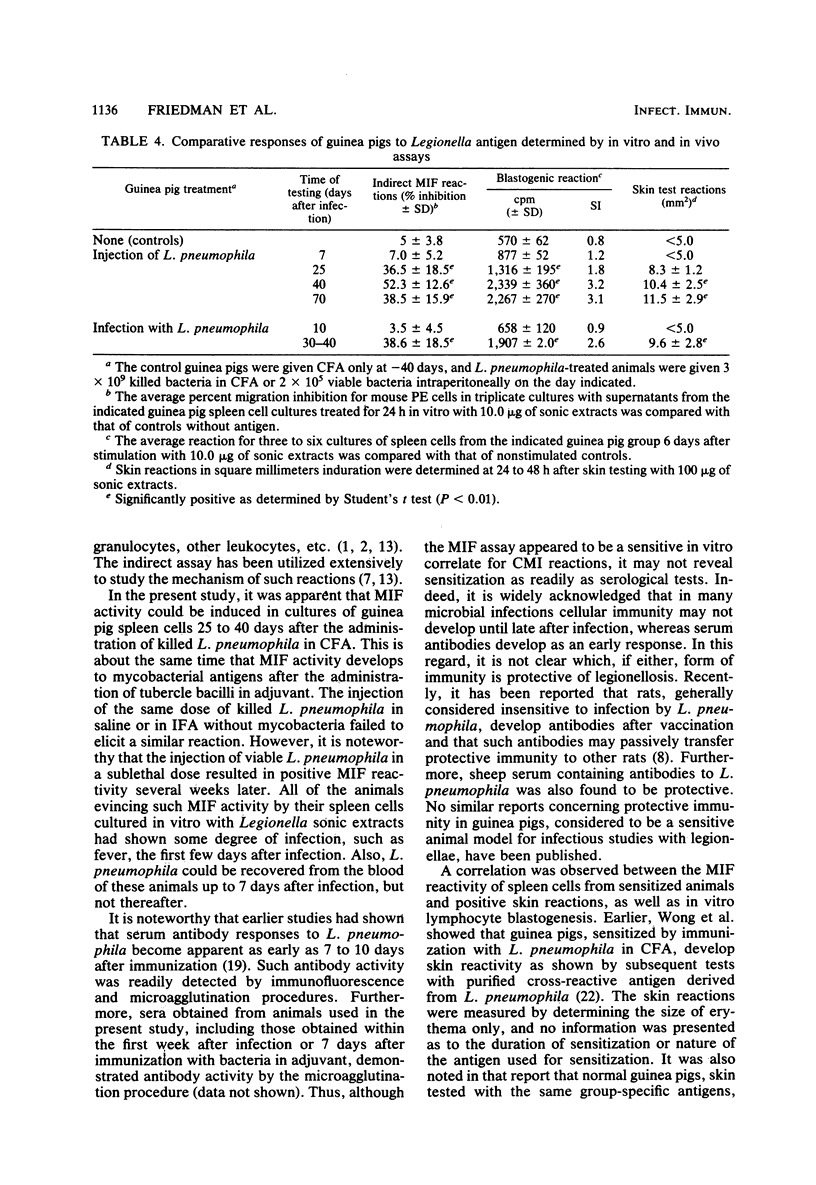
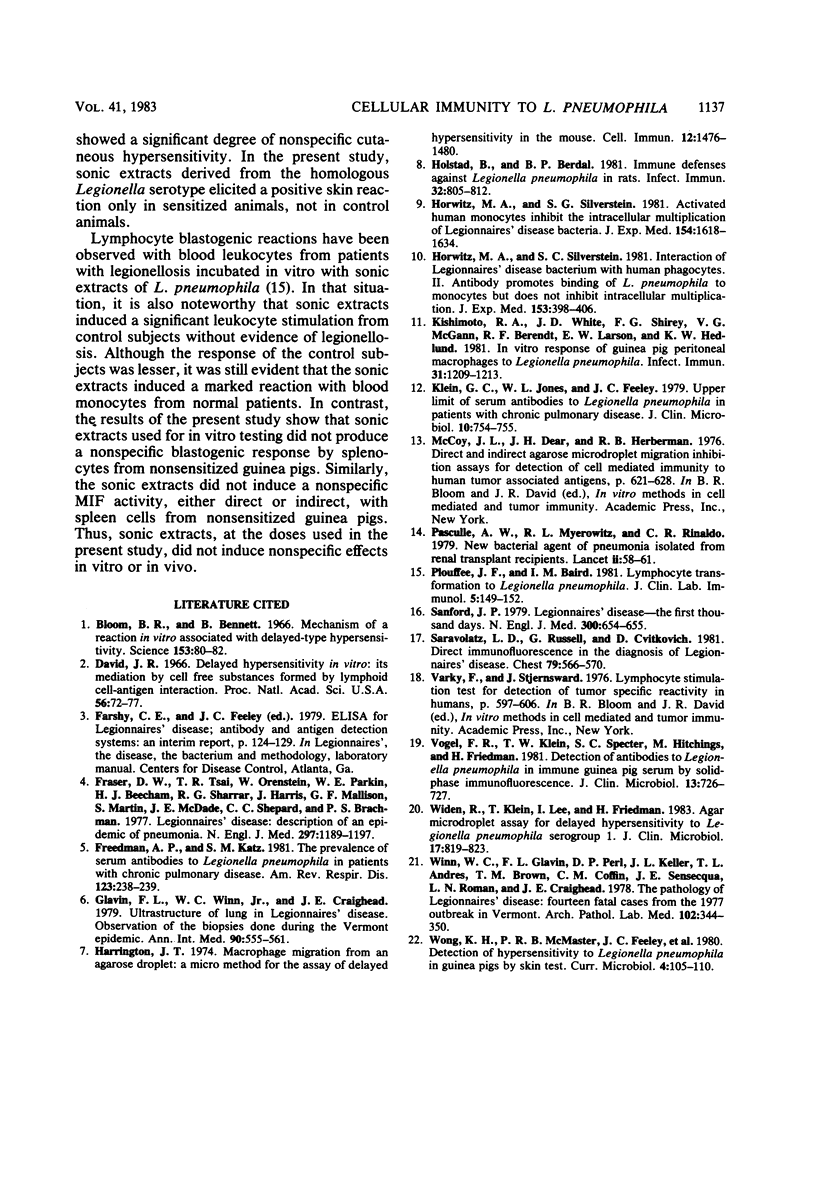
Selected References
These references are in PubMed. This may not be the complete list of references from this article.
- Bloom B. R., Bennett B. Mechanism of a reaction in vitro associated with delayed-type hypersensitivity. Science. 1966 Jul 1;153(3731):80–82. doi: 10.1126/science.153.3731.80. [DOI] [PubMed] [Google Scholar]
- David J. R. Delayed hypersensitivity in vitro: its mediation by cell-free substances formed by lymphoid cell-antigen interaction. Proc Natl Acad Sci U S A. 1966 Jul;56(1):72–77. doi: 10.1073/pnas.56.1.72. [DOI] [PMC free article] [PubMed] [Google Scholar]
- Fraser D. W., Tsai T. R., Orenstein W., Parkin W. E., Beecham H. J., Sharrar R. G., Harris J., Mallison G. F., Martin S. M., McDade J. E. Legionnaires' disease: description of an epidemic of pneumonia. N Engl J Med. 1977 Dec 1;297(22):1189–1197. doi: 10.1056/NEJM197712012972201. [DOI] [PubMed] [Google Scholar]
- Freedman A. P., Katz S. M. The prevalence of serum antibodies to Legionella pneumophila in patients with chronic pulmonary disease. Am Rev Respir Dis. 1981 Feb;123(2):238–239. doi: 10.1164/arrd.1981.123.2.238. [DOI] [PubMed] [Google Scholar]
- Glavin F. L., Winn W. C., Jr, Craighead J. E. Ultrastructure of lung in Legionnaires' disease. Observations of three biopsies done during the Vermont epidemic. Ann Intern Med. 1979 Apr;90(4):555–559. doi: 10.7326/0003-4819-90-4-555. [DOI] [PubMed] [Google Scholar]
- Horwitz M. A., Silverstein S. C. Activated human monocytes inhibit the intracellular multiplication of Legionnaires' disease bacteria. J Exp Med. 1981 Nov 1;154(5):1618–1635. doi: 10.1084/jem.154.5.1618. [DOI] [PMC free article] [PubMed] [Google Scholar]
- Horwitz M. A., Silverstein S. C. Interaction of the legionnaires' disease bacterium (Legionella pneumophila) with human phagocytes. II. Antibody promotes binding of L. pneumophila to monocytes but does not inhibit intracellular multiplication. J Exp Med. 1981 Feb 1;153(2):398–406. doi: 10.1084/jem.153.2.398. [DOI] [PMC free article] [PubMed] [Google Scholar]
- Kishimoto R. A., White J. D., Shirey F. G., McGann V. G., Berendt R. F., Larson E. W., Hedlund K. W. In vitro responses of guinea pig peritoneal macrophages to Legionella pneumophila. Infect Immun. 1981 Mar;31(3):1209–1213. doi: 10.1128/iai.31.3.1209-1213.1981. [DOI] [PMC free article] [PubMed] [Google Scholar]
- Klein G. C., Jones W. L., Feeley J. C. Upper limit of normal titer for detection of antibodies to Legionella pneumophila by the microagglutination test. J Clin Microbiol. 1979 Nov;10(5):754–755. doi: 10.1128/jcm.10.5.754-755.1979. [DOI] [PMC free article] [PubMed] [Google Scholar]
- Pasculle A. W., Myerowitz R. L., Rinaldo C. R., Jr New bacterial agent of pneumonia isolated from renal-transplant recipients. Lancet. 1979 Jul 14;2(8133):58–61. doi: 10.1016/s0140-6736(79)90117-x. [DOI] [PubMed] [Google Scholar]
- Plouffe J. F., Baird I. M. Lymphocyte transformation to Legionella pneumophila. J Clin Lab Immunol. 1981 May;5(3):149–152. [PubMed] [Google Scholar]
- Rolstad B., Berdal B. P. Immune defenses against Legionella pneumophila in rats. Infect Immun. 1981 May;32(2):805–812. doi: 10.1128/iai.32.2.805-812.1981. [DOI] [PMC free article] [PubMed] [Google Scholar]
- Sanford J. P. Legionnaires' disease--the first thousand days. N Engl J Med. 1979 Mar 22;300(12):654–656. doi: 10.1056/NEJM197903223001205. [DOI] [PubMed] [Google Scholar]
- Saravolatz L. D., Russell G., Cvitkovich D. Direct immunofluorescence in the diagnosis of Legionnaires' disease. Chest. 1981 May;79(5):566–570. doi: 10.1378/chest.79.5.566. [DOI] [PubMed] [Google Scholar]
- Vogel F. R., Klein T. W., Specter S. C., Hitchings M., Friedman H. Detection of antibodies to Legionella pneumophila in immune guinea pig serum by solid-phase immunofluorescence. J Clin Microbiol. 1981 Apr;13(4):726–729. doi: 10.1128/jcm.13.4.726-729.1981. [DOI] [PMC free article] [PubMed] [Google Scholar]
- Widen R., Klein T., Lee I., Friedman H. Agar microdroplet assay for delayed hypersensitivity to Legionella pneumophila serogroup 1. J Clin Microbiol. 1983 May;17(5):819–823. doi: 10.1128/jcm.17.5.819-823.1983. [DOI] [PMC free article] [PubMed] [Google Scholar]
- Winn W. C., Jr, Glavin F. L., Perl D. P., Keller J. L., Andres T. L., Brown T. M., Coffin C. M., Sensecqua J. E., Roman L. N., Craighead J. E. The pathology of Legionnaires' disease. Fourteen fatal cases from the 1977 outbreak in Vermont. Arch Pathol Lab Med. 1978 Jul;102(7):344–350. [PubMed] [Google Scholar]


